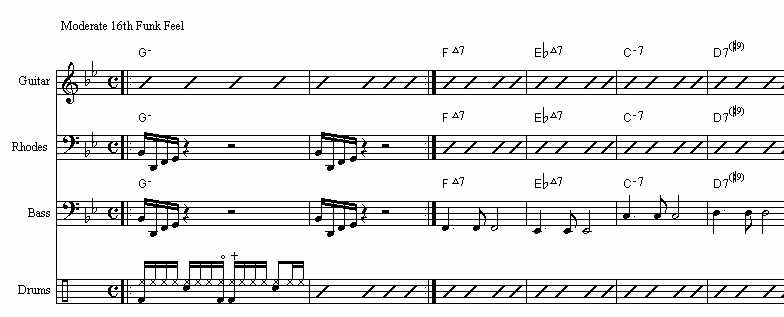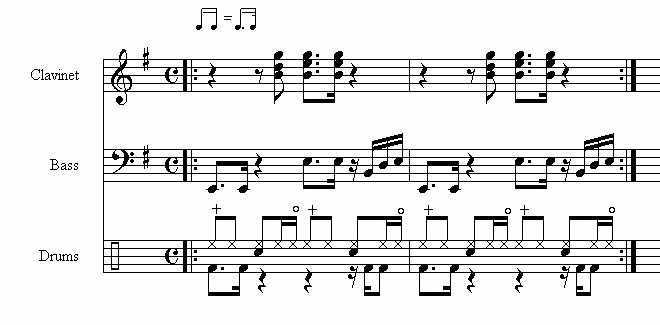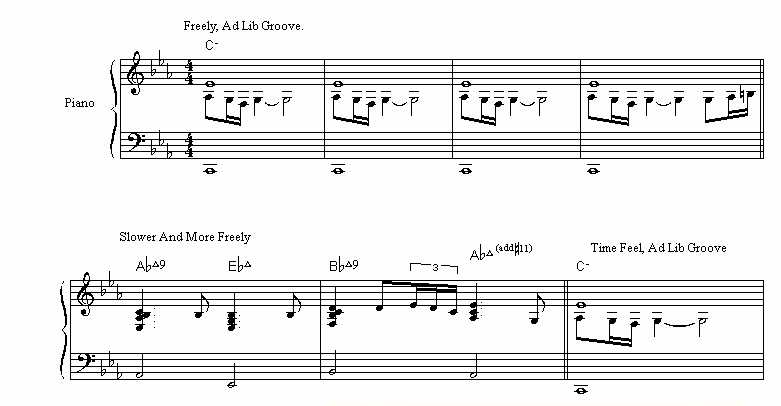
|
|
|
He can't play that great, so I guess it's not that much use to you, but hey Tim said that he always wanted to take a Master Class.� This is as close as he'll get... |
| Example 1 : The "Conspiracy Theory" Groove. |
|
A Mike Tomaro piece, original written for a small 5 piece fusion band and latter re-arranged for Big Band, Tim has 'borrowed" this piece for it's simple fusion/funk style groove. "The opening groove from this piece is a simple funk-shuffle style thing in G minor.� In the riff there is a Am7/G, which gives a really crisp feel with the natural sixth of G minor, E natural, providing a little bit of spark to the harmonic structure of the groove.� Alternating between the simple Rhodes riff and clavinet interventions, this groove sets up a typical fusion-funk style groove.� The chord structure�(of the entire piece) is a lot more complex than what is printed in the following example, although I like to start of the piece with a solo keyboard (Rhodes and Clav) vamp on just the G-minor chord.� Here's the music, take it at a reasonably relaxed tempo and remember that semi-quavers are swung." |
 |
| Down Load Tim playing Conspiracy Theory (Example 1): |
| "Conspiracy Theory" |
| Example 2 : "The Set-Opener". |
|
One of Tim's compositions, this piece is, as they title implies, a set opener. A very simple funk groove is laid down by the rhythm section whilst the vocalist speaks/sings/whatever over the top. "This is the opening section to "The Set Opener". A lot of talentent funk musicians say that "Funk is in the space", I think this is a good example of that. (Though I'm not a very talented musician, I can agree with the good ones, right!?) The bass and rhodes play in unison over a 16th style drum pattern and a wah muted string guitar pattern. Basically it's a platform to set up atmosphere for the vocalist to ad lib an introduction to the band over the top of us. You know, he can chat to the audience and stuff. Anyway, a lot of players try and play to much. There is such a thing as too much, and it's a lot easier to define than too little." |
 |
| Down Load Tim playing "The Set Opener". Tim apologises for the cheesy sequencing of the rest of the rhythm section- "Due to the technical difficulties involved in recording the entire band, I left the guitar and vocal lines out and sequenced the bass and drums. There is a bit more happening in the Rhodes part (on the recording) than what's written. I'd usually save this stuff for later on in the piece, perhaps the second or third verse. Since there isn't any vocal or guitar though, I thought I should fill it out a bit... "(Example 2): |
| "The Set Opener" |
| Example 3 : The Funk To Come... |
|
Here is an example of an untitled piece in the making. "When I write, I do it many different ways. Sometimes I'll write a piece based on a chord progression, sometimes on a ryhthmic element or sometimes just on a simple groove. This piece here is an example of the later style of development. It is a simple funk style groove, at the moment with no vocals or guitar. The groove consists of a bass line, drums and clavinet stabs. Notice that the clavinet stabs allow the drum/bass groove to come through. Often I would play a left hand bass part on the clav as well, but for this one I left a clav bass line out. From here, as any section of music can, it can take any number of directions, both in rhythmic and melodic development. Just where this one will end, well who knows? It may never be completed, or it may be something that never gets played. It may be the next no 1 (I wish! Hey, you never know! I wouldn't be the first talentless person to write a no 1.)" |
 |
| Down Load Tim playing this piece in the making. Tim apologises once again for the cheesy sequencing. After bar 4, the sound file continues and Tim start jamming away on the clav. |
| "The Funk To Come..." |
| Example 4 : I suppose a Ballad is necessary... |
|
Here is another example of a work in the making, entilted "Peace", this is much closer to being finished than the last one. "I write quite a few ballads, not many of them get performed becuase they tend to be "Art-Pop" style. Once again I'm not sure what direction this will take. I've pretty much written the chord structure, and to an extent, the melody. I may leave it as a solo for piano or rhodes, or perhaps a whole band instrumental. I may end up writing lyrics for it, but who knows? Interestingly enough, with this Master Class having the topic of grooves, this piece doesn't have the most definite of feels (rhythmically speaking). It's actually quite free in time, but the chord structure creates movement and life." |
 |
| Down Load Tim playing an excerpt from "Peace": |
| "Peace" |
| "Well, I hope you enjoyed my first Master Calss. Just remember, music comes from everything in your life, not just your hands. Always experiment, try new things, don't be afriad to jump in the deep end and learn how to apologise to the band when that new tangent doesn't work out. Most of all though, learn how the be smug when that new direction blows there minds. (I'm still waiting for that to happen!) Oh, and make sure enjoy yourself. At least that way your guaranteed that at least one person will be having a good time because of your music. Chances are if it's you it'll rub off on to the audience and your fellow band members. " - Tim |
| "The Set Opener", "Peace" and the groove from the untitled work are all copyrighted by Tim Shawcross. |
|
Tune in next month for: "An analysis of the songs I've written for girls... And why they went wrong. Was it the music or just me? |
|
|
|
|